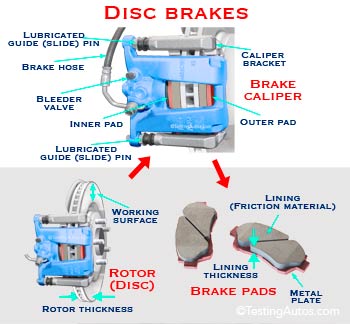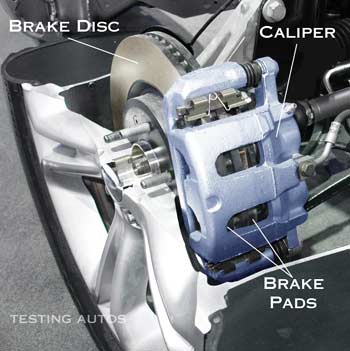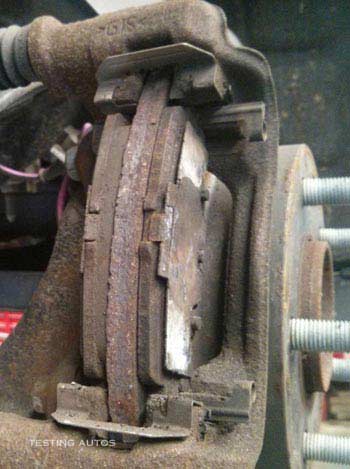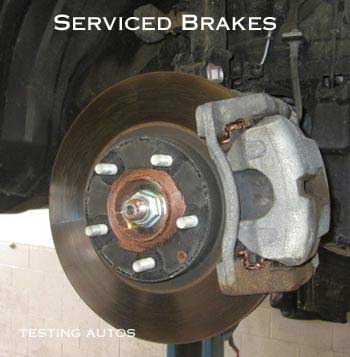How Often Do Automobile Brakes Need Service?
How often do brakes need to be serviced?
Updated: April 22, 2020
Brakes should be replaced when worn out, just how often do brakes need servicing? Servicing brakes means servicing the brake components (cleaning, lubricating, etc.) without replacing them. Brakes are serviced to make sure they office properly between replacements and the car is prophylactic to drive.
 Disc brakes.
Disc brakes.
Brakes need to be inspected regularly and serviced when needed: for example, when some of the parts evidence signs of sticking or seizing up, or when rust or dirt buildup causes brake noises. Some car makers include brake service into the maintenance schedule, others specify that brakes need to be inspected in regular mileage or time intervals; typically every 5,000-7,000 miles or every 4-6 months, whichever comes beginning.
Brakes as well need to be inspected and serviced (or replaced) if they are not working properly, squeak, grind or produce other abnormal noises, or if the brake pedal doesn't feel "right." The benefits of servicing brakes are that the restriction pads or shoes vesture more evenly and final longer and the brakes are less likely to squeak. Servicing brakes is especially important in the "salt belt" because presence of road salt speeds up the corrosion of brake parts.
Almost cars on the road today accept disc brakes on all four wheels. Some vehicles accept drum brakes on the rear wheels. How disc brakes piece of work: the brake pads are installed on both sides of the brake disc (also known as rotor). When a driver presses the restriction pedal, the hydraulic pressure pushes the piston (or pistons) out of the brake caliper. As a result, the two brake pads squeeze the brake disc between them.
To work properly, the restriction pads have to be able to slide inside the brake caliper towards and away from the disc.
 Front disc brakes.
Front disc brakes.
In a restriction organization with a floating caliper found in about cars (in the photo), the caliper itself also must be able to slide laterally on its bracket (ballast plate). In this design, the caliper slides on two guide (slide) pins.
The disc brakes endure a lot of heat when braking and can get moisture during the rain. As a result, the restriction components tin rust. Rust buildup may crusade brake pads to stick within the subclass or the brake caliper guide (slide) pins to seize up, run into the photo below. This problem is very common in regions where road salt is used in the winter.
When brake pads stick, or the caliper seizes up, the brakes might non work properly or non release fully. This will crusade the brakes to overheat and the brake performance will be compromised.
 Road salt caused excessive rust buildup in this vehicle. The restriction pads were sticking and worn out prematurely. The outer pad is worn more.
Road salt caused excessive rust buildup in this vehicle. The restriction pads were sticking and worn out prematurely. The outer pad is worn more.
The brake caliper might get damaged from overheating and crave replacement. For many cars, this event is the number i crusade of premature or uneven restriction pad wearable and brake caliper replacement. A squeaking dissonance coming from brakes is one of the possible symptoms of this problem.
Similar issues happen with rear pulsate brakes: rust on the brake drums can cause squeaking, and some components, particularly the parking restriction parts, may seize upward due to corrosion or lack of lubrication. In almost cars, drum brakes accept a self-adjusting mechanism that may as well seize upwardly. In fourth dimension, a seized self-adjuster may cause longer pedal travel. Of course, pulsate brakes are fully covered by the drum, and they usually can terminal longer without servicing.
In most service shops and dealerships, mechanics inspect your brakes whenever your wheels are removed when doing a tire rotation or other service. Brakes cannot be properly inspected without removing the wheels. For this reason, we recommend having your brakes properly inspected at least once a yr to continue your car safe. Check the reviews when choosing the store; y'all don't want to trust your brakes to incompetent mechanics.
The brake inspection typically involves checking the brake components according to the manufacturer's guidelines. For instance, measuring the brake pad or brake shoe material thickness and inspecting brake discs.
 Freshly serviced brakes.
Freshly serviced brakes.
If there are signs that pads or caliper guide (slide) pins are not moving freely, your mechanic may recommend servicing your brakes.
The disc brake service includes removing the pads and calipers, cleaning and lubricating guide pins and the caliper brackets to prevent sticking or seizing. The brake discs (rotors) might too demand to be cleaned out from the surface rust, especially on the edges, to forbid squeaking. Servicing brakes must also exist done following the manufacturer's instructions.
The rear drum restriction service involves cleaning the components, including the parking brake parts and lubricating parts that need to be lubricated, besides as removing excessive rust buildup from the drums. Rear drum brakes and the parking brake might also need to be re-adjusted.
Should you service the brakes or supervene upon them? If the brake pads are worn close to the safe limit or the discs are in bad shape, it might be more than cost effective to replace brakes instead of servicing them. To help you decide, ask your mechanic or service writer how long the brakes volition last if you service them now.
Is the car safe to drive if y'all decide not to service brakes, but rather replace them afterward? What is the toll difference?
How long do the brakes last before they need to exist replaced? On boilerplate, disc brakes final for xxx,000-50,000 miles. Rear drum brakes terminal longer, sometimes up to 150,000 miles.
How much does a brake service cost? Typically a brake service costs $80-$130 per axle if no parts are replaced. Both brakes on the same beam are always serviced at the same fourth dimension. If your brake discs or drums are rusted, warped, or worn unevenly, your mechanic may propose having them machined (resurfaced) on the brake lathe. This costs more. Warped or unevenly worn brake discs or drums cause steering vibration and brake pedal pulsation while braking.
How Often Do Automobile Brakes Need Service?,
Source: https://www.testingautos.com/car_care/how-often-to-service-brakes.html
Posted by: williamsvanctiod.blogspot.com


0 Response to "How Often Do Automobile Brakes Need Service?"
Post a Comment